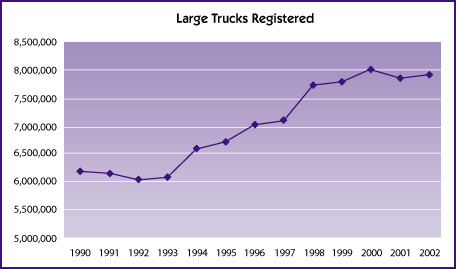Vehicle Size and Weight Overview
Vehicle Size and Weight Challenges
In recent years, growth in trade has increased the number of commercial vehicles on our roadways and indirectly, the demand for more productive and potentially larger commercial trucks. The Federal Highway Administration (FHWA) reports that there were approximately 7.9 million large trucks (truck with six or more tires) in 2002 compared with 6.2 million in 1990. The growing number of large trucks has heightened public awareness of the need to improve commercial vehicle safety and preserve highway infrastructure.

Federal interest in preserving highways goes back to the 1950s when the Dwight D. Eisenhower System of Interstate and Defense Highways was created. Initially, Federal interest was focused on enforcing a national vehicle weight standard, which became law in 1956. Subsequent laws added national length and width standards. Congress also expanded the scope of Federal oversight to include not only the interstate system, but also designated State primary system roads, which together make up the National Network of Highways.
To keep trucks moving safely and efficiently and preserve our nation’s infrastructure, States must ensure that vehicles comply with size and weight standards. FHWA is responsible for certifying State compliance with Federal regulations. The national Vehicle Size and Weight Team, a part of FHWA’s Office of Freight Management and Operations, oversees State enforcement of size and weight standards for heavy trucks and buses in the United States. FHWA’s policy and legal staff assist the team. In addition, staff in each of FHWA’s 52 Division Offices provides one-on-one support to individual States, the District of Columbia, and Puerto Rico. FHWA Headquarters and Division Office staff also assists with policy questions, clarifications, reporting requirements, training, and other related program and administrative issues.
Why We’re Concerned
Trucking is a key component of the U.S. economy. Trucks moved 71 percent of the total tonnage and 80 percent of the total value of U.S. shipments in 1998. The importance of trucking will increase significantly in the coming years. FHWA forecasts that trucks will move significantly more tons in 2020, capturing a somewhat larger share of total freight tonnage. Yet the addition of new lane-miles is not expected to keep pace with the increased demand for freight transportation and the growth in passenger travel. Therefore, the need to preserve existing infrastructure is a high priority.
What We’ve Learned
State officials understand the need for commercial vehicle size and weight enforcement and recognize its link to enhanced highway safety and infrastructure preservation. State enforcement activity data, including citations issued to nonconforming motor carriers, are helpful in determining a State’s level of effort and directing corrective action. These annual data also may serve to complement and offer perspectives on other State data obtained by FHWA, such as commercial vehicle-miles traveled and investments made in highway and bridge maintenance. Increasingly, FHWA seeks to use size and weight data in its analysis and forecasting of future surface transportation needs.

Future Directions
The Commercial Vehicle Size and Weight Team has identified several activities that will streamline State reporting and evaluation. They include automating the reporting system, providing training sessions to State departments of transportation, and working with States to identify best practices.
Automate the State Reporting Process
Each State is required to submit an annual State Enforcement Plan (SEP) describing procedures, resources, and facilities that it intends to devote to enforcement of its vehicle size and weight laws. The SEP, which is submitted to FHWA by July 1 of each year, must be approved by FHWA and be in effect by October 1 of each year. Each State must then certify in a separate report to FHWA before January 1 of each year that it is enforcing all State laws regarding size and weight. The entire process is done on paper. Using information technologies, an automated reporting system is being developed. It will include a Web site to assist in report preparation, provide guidance on reporting requirements, share information on best practices, offer electronic access to regulatory interpretations, and a “chat room” for discussions of current issues. Once it is implemented, the electronic system will reduce the time needed to develop and submit State reports and speed up the analysis and approval process.
Conduct Training Sessions
Initial training workshops are now being created for Federal and State employees engaged in the administration and enforcement of commercial vehicle size and weight programs. The training covers various statutory provisions and exceptions, best practices, noteworthy State programs, and guidance in preparing reports.
As part of the training sessions and outreach, FHWA will work with States to assess their ability to measure size and weight infractions, evaluate their effects, and determine related infrastructure costs.
The Commercial Vehicle Size and Weight Team will continue to deal with a myriad of issues reflecting the diverse provisions and requirements of the 50 States, the District of Columbia, Puerto Rico, and respective FHWA Division Offices. FHWA will explore opportunities for simplifying and streamlining programs and promote greater stakeholder interaction.

The enforcement of Federal standards and limitations by State agencies, using Federal resources and guidelines, is integral to preventing the premature deterioration of highway surfaces and infrastructure and to provide a safe driving environment for both commercial and private vehicles operating on the nation’s highways.
For more information on Vehicle Size and Weight, please visit hhttps://ops.fhwa.dot.gov/freight/sw/index.htm
For more information on FHWA Office of Operations activities, visit our web site at https://www.fhwa.dot.gov/operations
April 2004
FHWA-OP-04-056
previous | next